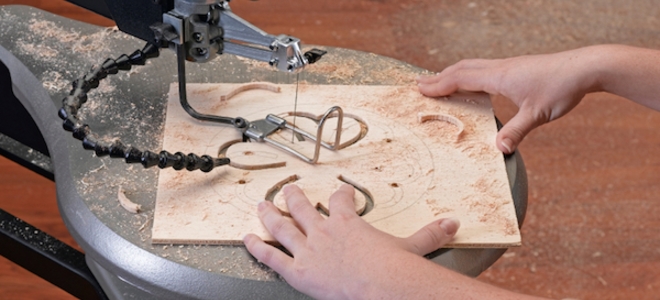
For woodworkers, the best scroll saw is a vital tool. It is used to create crisp fretwork and detailed crafts in a way that is impossible for other machines. There are a number of features on this type of saw that needs to be mastered to get the best results. Below are a few tips and trips that can assist you in making your projects easier to accomplish, more successful and more enjoyable:
Blade Tension
The tension of the blade should not be too tight or too loose as both scenarios could cause breakage. The tension should be set to the point where a ‘ping’ can be heard when the blade is plucked. If there is breakage immediately after it is engaged, the tension could be too tight. If it wanders, it could be too loose.
Lighting
Lighting is important to properly see the lines of the pattern. Without the proper lighting, you may end up having a perception problem that causes the visual merging of the black line of the pattern and the black blade. This would make it difficult to achieve precision. As such, it is vital for lights to be mounted onto the saw. Otherwise, a lamp can be strategically placed near the saw to enhance visibility. A magnifier can be used for more precision.
Blade Retrieval
Minimizing the length of time it takes to change the blades is a valuable skill to learn. After about 3o minutes of use, most blades starts to dull or might even break. As such, you’ll need a readily-available additional supply of blades. Placing them on a magnetic strip that is attached to the saw stand is an easy way to have quick access.
Successful Drill Pressing
Drilling holes through thin pieces of wood can be tricky; however, splitting can be prevented if you place a scrap of wood underneath the material being cut. When drilling through thick pieces of wood, it is important to drill down to the point where only the bottom surface is pierced. At this point, stop drilling, spin it over to get the bottom surface facing upwards and complete the drilling from this side.
Ensuring Stacked Parts are Kept Together
When stack cutting, use cyanoacrylate glue to keep the different pieces together. Use the glue moderately to prevent it from spreading to parts that should be separated after the cut is completed. Alternatively, clear packing tape could be used to hold the stack in place.
Burn Prevention
To prevent your hardwood pattern from burning, place transparent packaging tape on top of it. This lubricates the blade and prevents the accumulation of sawdust. When harder and thicker materials are being used, the saw should be set at a higher speed and a lower speed is required for thinner and softer woods.
Check the Teeth
Before starting the saw, the direction of the teeth should always be checked. Ensure they are pointing down and positioned to the front of the saw. An incorrectly-installed blade will not function. If installed upside down, the blade will pick up the material and slam it back down. Sometimes smaller blades rotate while the blade is being adjusted; therefore, ensure it is pointing in the correct direction.
Scrolling Position
A scroll saw can be operated while sitting or standing. Beginners should stand in front of the saw as this will allow him or her to feed the material easily into the blade and more seamlessly operate the saw. Regardless of your position, you should always be comfortable as this type of activity could last for hours. Being comfortable will eliminate or minimize the effects of fatigue and stiff joints. If you opt to sit, a swivel chair would be ideal as it can be raised higher and the saw can be adjusted for maximum effectiveness. Consider using a Pedal Foot Switch for a safer and less challenging experience.
Maintenance of Scroll Saw Blades
Blades are susceptible to rusting when stored for extended periods. Spraying a thin coat of oil or WD40 on them can remedy this.
Final Thoughts
To master the scroll saw, patience and practice are necessary. The previously-outlined tips and tricks are supported by different scroll saw reviews. They will assist in enhancing your skills.
